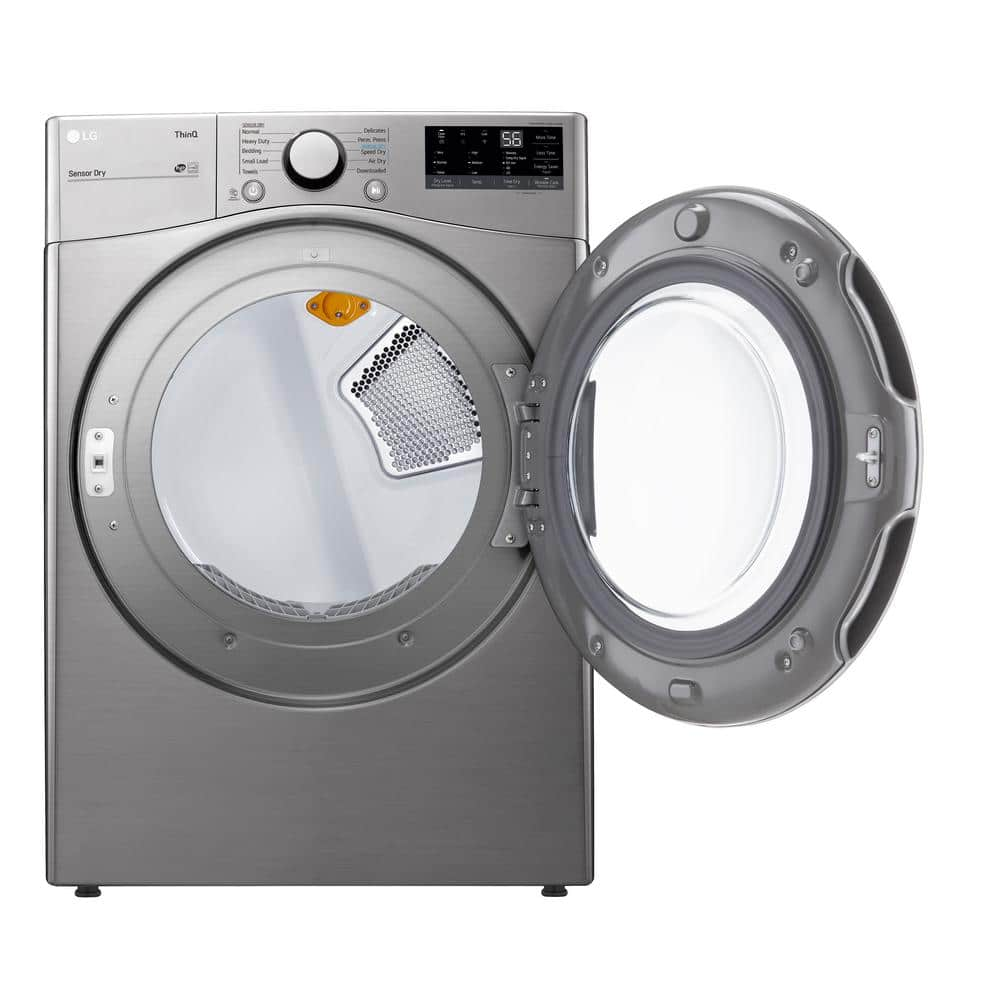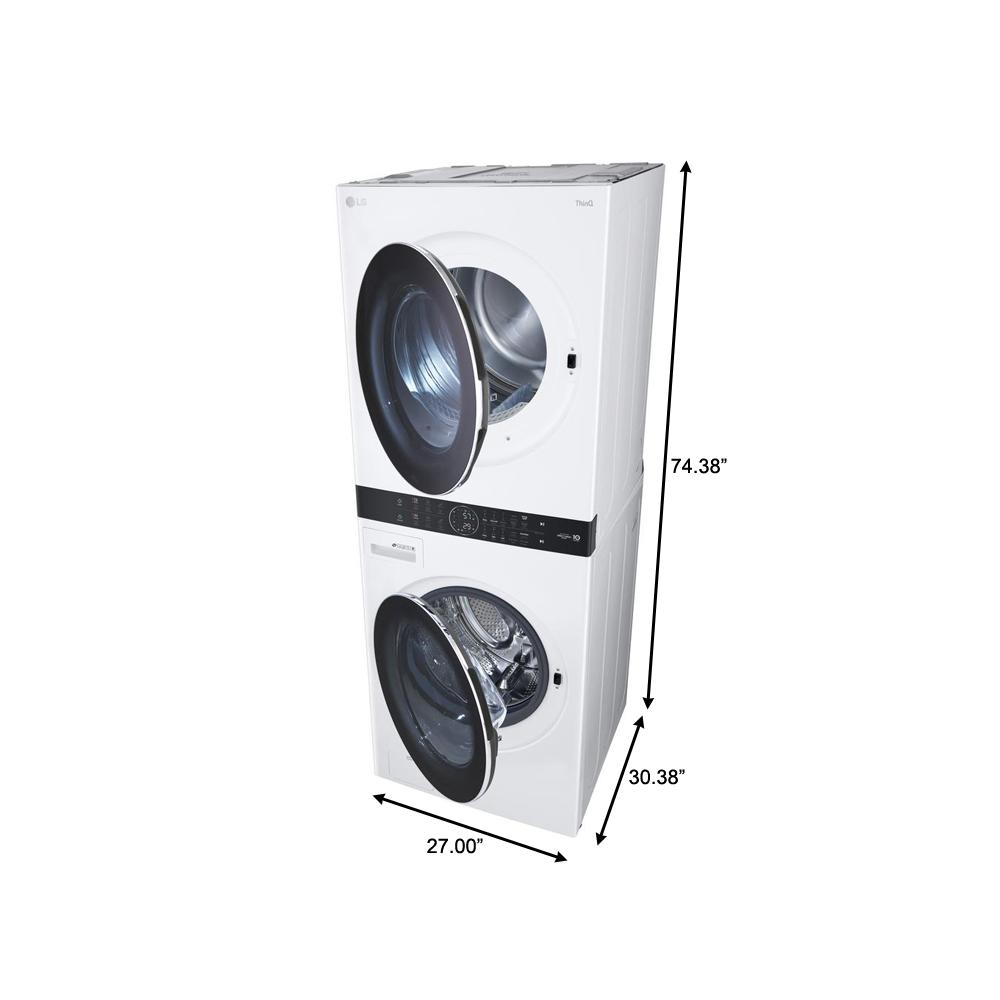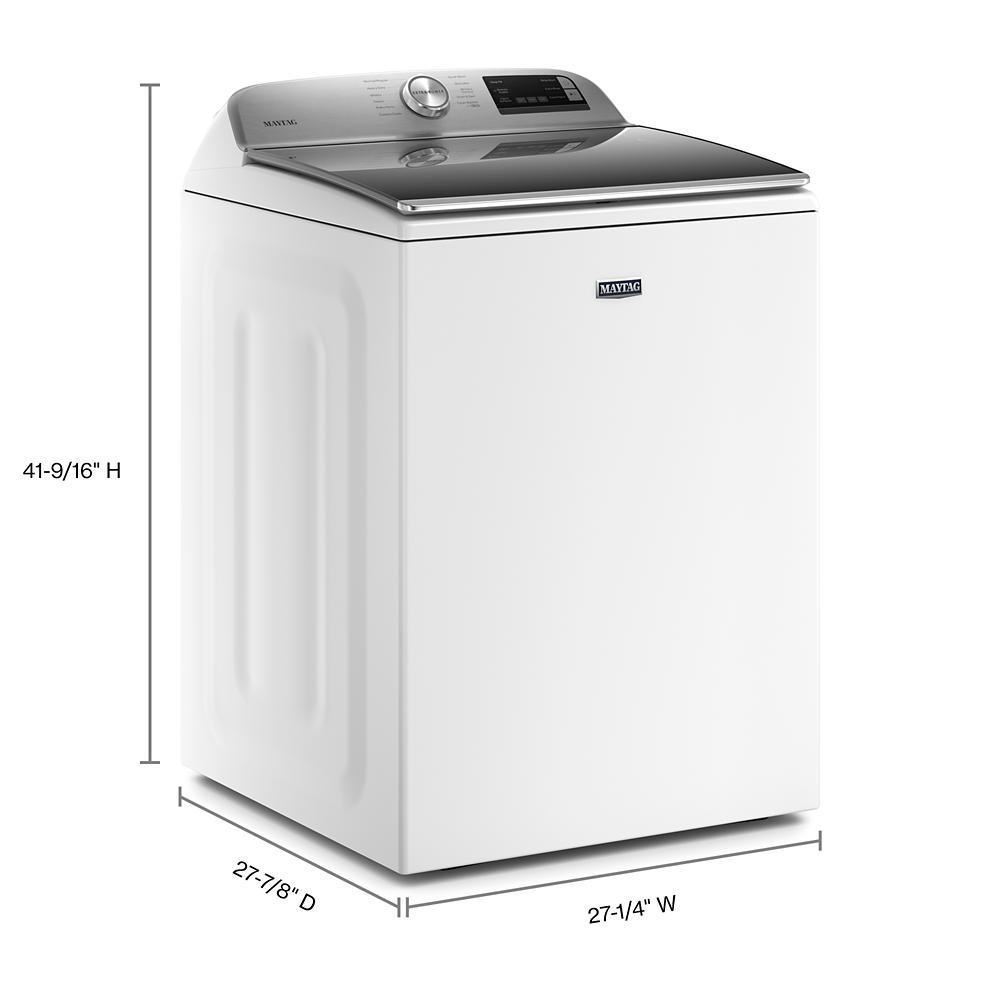LG 7.4 cu. ft. Ultra Large Graphite Steel Smart Electric Vented Dryer with Sensor Dry & Wi-Fi Enabled
Built-in intelligence selects optimal dry motions and settings. Sensor Dry measures moisture level and auto adjusts to ensure dry. ThinQ Technology with Proactive Customer Care.
Tired of toggling through endless cycles only to have clothes come out damp or overdry. This dryer takes out the guesswork, with built-in intelligence that uses advanced sensors and AI technology to automatically select the right drying motions, temperatures and more. It can even talk to your washer to select a compatible cycle – so you don’t have to. What could be easier, use the ThinQ app to start or stop the dryer from anywhere, and even receive an alert when clothes are dry. Durable and stylish tempered glass door with white or silver accents adds the perfect finish.
- Free up your day-fit more clothes in every load with 7.4 cu. ft. of space. Running fewer loads saves energy and money on your utility bill.
- Forget about endless sorting or toggling through cycles – built-in sensors use AI technology to detect fabric texture and load size, then automatically select the right drying motions, temperatures and more for advanced fabric care; sensor Dry detects moisture levels and automatically adjusts drying time for loads of all sizes – no more damp clothes, no more overdrying; with Smart Pairing, the washer can even tell the dryer to select a compatible drying cycle, making it the ultimate laundry hack
- No matter where you are, use the ThinQ app to start the dryer, extend cycle time to avoid wrinkles and receive an alert when clothes are dry; go hands-free – select dryer features work with Alexa and the Google Assistant; never run out of dryer sheets again – Amazon dash replenishment service tracks usage and automatically delivers dryer sheets right to your door; proactive customer care offers preventative maintenance tips and alerts and expedited repairs, for enhanced satisfaction plus improved product performance
- LG front load washers and dryers are the first to use tempered glass doors for a sleek, stylish look that resists shock and scratches; the premium feel is further enhanced by matching door trim and control knob accents; Disclaimer: Accent colors and finishes vary by model; Door trim and matching control knob accents available in white/silver
- FlowSense Duct Clogging and Lint Filter Indicators let you know when your ducts and filter need cleaning to avoid lint buildup, improve the dryer’s performance for greater efficiency and lower utility bills, and help give you safer, worry-free operation with fewer service calls
- High efficiency sensor drying and low-heat settings save energy and money by using about 20% less energy than conventional models without sacrificing features or performance
- LG closet-depth washers and dryers are worth showing off, but when space dictates otherwise it’s good to know they’ll easily fit in a closet with plenty of room to close the closet door; install the pair side-by-side, or get a stacking kit and install the dryer over the washer to save even more space
- An advanced aluminized alloy coating is added to the steel dryer drum to enhance durability and maintain its luster and attractive finish; helps keep nicks and chips at bay so your dryer looks like new even after years of use
- Run the dryer whenever you want, without interrupting naptime or your favorite show; this dryer is designed for quiet operation, from the motor to the cabinet to individual components; pleasant end-of-cycle chime lets you know when clothes are dry
- When space is tight or your laundry room doesn’t fit the “typical” setup, this dryer’s door can easily be reversed to fit your needs; go from a right swing to a left swing in minutes – just unscrew the hinges and reattach using the pre-drilled holes on the opposite side
- When you hate wrinkles but can’t be there to remove clothes as soon as they’re dry, just select the Wrinkle Care option before hitting start; the dryer will periodically tumble the load for up to 3 hours after the cycle is done or until the door is opened to help keep wrinkles at bay
- Stackable with matching washer (WM3500CW) to conserve space within your laundry room with stack kit (model: KSTK1) sold separately
- 10 wash programs; Normal, Perm. Press, Heavy Duty, Delicates, Towels, Speed Wash, Bedding, Tub Clean, Whites, additional downloadable programs also available
- 11 wash options; Fresh Care, Prewash, Remote Start, Delay Wash, wi-fi, Add, Garments, ColdWash, Water Plus, Extra Rinse, Rinse+Spin, Child Lock
- All compatible LG washers, dryer, SideKick pedestal washers, and laundry pedestals sold separately
Additional information
| Depth With Door Open 90 Degrees (In) | 51 |
|---|---|
| Door Opening Height x Width (In.) | 16.06 x 16.06 |
| Product Depth x Height x Width (in.) | 30.125 x 39 x 27 |
| Certifications and Listings | CSA Listed,Energy Star |
| Manufacturer Warranty | Parts and Labor 1 Year |
4 (four) is a number, numeral and digit. It is the natural number following 3 and preceding 5.
4 is the smallest square number > 1, the smallest semiprime and composite number, and the 3rd highly composite number.
The number 4 is considered unlucky in many East Asian cultures.
7 (seven) is the natural number following 6 and preceding 8. It is the only prime number preceding a cube.
As an early prime number in the series of positive integers, the number seven has greatly symbolic associations in religion, mythology, superstition and philosophy. The seven classical planets resulted in seven being the number of days in a week. 7 is often considered lucky in Western culture and is often seen as highly symbolic. Unlike Western culture, in Vietnamese culture, the number seven is sometimes considered unlucky.
Dry or dryness most often refers to:
- Lack of rainfall, which may refer to
- Arid regions
- Drought
- Dry or dry area, relating to legal prohibition of selling, serving, or imbibing alcoholic beverages
- Dry humor, deadpan
- Dryness (medical)
- Dryness (taste), the lack of sugar in a drink, especially an alcoholic one
- Dry direct sound without reverberation
Dry or DRY may also refer to:
Graphite () is a crystalline allotrope (form) of the element carbon. It consists of many stacked layers of graphene, typically in the excess of hundreds of layers. Graphite occurs naturally and is the most stable form of carbon under standard conditions. Synthetic and natural graphite are consumed on a large scale (1.3 million metric tons per year in 2022) for uses in many critical industries including refractories (50%), lithium-ion batteries (18%), foundries (10%), lubricants (5%), among others (17%). Under extremely high pressures and extremely high temperatures it converts to diamond. Graphite's low cost, thermal and chemical inertness and characteristic conductivity of heat and electricity finds numerous applications in high energy and high temperature processes.
LG Corporation (or LG Group), formerly known as Lucky-Goldstar, is a South Korean multinational conglomerate founded by Koo In-hwoi and managed by successive generations of his family. It is the fourth-largest chaebol (family-run conglomerate) in South Korea. Its headquarters are in the LG Twin Towers building in Yeouido-dong, Yeongdeungpo District, Seoul. LG makes electronics, chemicals, household appliances, and telecommunications products and operates subsidiaries such as LG Electronics, Zenith, LG Display, LG Uplus, LG Innotek, LG Chem, and LG Energy Solution in over 80 countries. According to the “Top 500 Global Brands” released by British consulting firm Brand finance, LG's brand value ranking rose from 90th to 83rd from the previous year.
A sensor is a device that produces an output signal for the purpose of detecting a physical phenomenon.
In the broadest definition, a sensor is a device, module, machine, or subsystem that detects events or changes in its environment and sends the information to other electronics, frequently a computer processor.
Sensors are used in everyday objects such as touch-sensitive elevator buttons (tactile sensor) and lamps which dim or brighten by touching the base, and in innumerable applications of which most people are never aware. With advances in micromachinery and easy-to-use microcontroller platforms, the uses of sensors have expanded beyond the traditional fields of temperature, pressure and flow measurement, for example into MARG sensors.
Analog sensors such as potentiometers and force-sensing resistors are still widely used. Their applications include manufacturing and machinery, airplanes and aerospace, cars, medicine, robotics and many other aspects of our day-to-day life. There is a wide range of other sensors that measure chemical and physical properties of materials, including optical sensors for refractive index measurement, vibrational sensors for fluid viscosity measurement, and electro-chemical sensors for monitoring pH of fluids.
A sensor's sensitivity indicates how much its output changes when the input quantity it measures changes. For instance, if the mercury in a thermometer moves 1 cm when the temperature changes by 1 °C, its sensitivity is 1 cm/°C (it is basically the slope dy/dx assuming a linear characteristic). Some sensors can also affect what they measure; for instance, a room temperature thermometer inserted into a hot cup of liquid cools the liquid while the liquid heats the thermometer. Sensors are usually designed to have a small effect on what is measured; making the sensor smaller often improves this and may introduce other advantages.
Technological progress allows more and more sensors to be manufactured on a microscopic scale as microsensors using MEMS technology. In most cases, a microsensor reaches a significantly faster measurement time and higher sensitivity compared with macroscopic approaches. Due to the increasing demand for rapid, affordable and reliable information in today's world, disposable sensors—low-cost and easy‐to‐use devices for short‐term monitoring or single‐shot measurements—have recently gained growing importance. Using this class of sensors, critical analytical information can be obtained by anyone, anywhere and at any time, without the need for recalibration and worrying about contamination.
Smart may refer to a high level of intelligence or "street smarts".
"Smart" or SMART may also refer to the following.
Steel is an alloy of iron and carbon with improved strength and fracture resistance compared to other forms of iron. Because of its high tensile strength and low cost, steel is one of the most commonly manufactured materials in the world. Steel is used in buildings, as concrete reinforcing rods, in bridges, infrastructure, tools, ships, trains, cars, bicycles, machines, electrical appliances, furniture, and weapons.
Iron is always the main element in steel, but many other elements may be present or added. Stainless steels, which are resistant to corrosion and oxidation, typically need an additional 11% chromium.
Iron is the base metal of steel. Depending on the temperature, it can take two crystalline forms (allotropic forms): body-centred cubic and face-centred cubic. The interaction of the allotropes of iron with the alloying elements, primarily carbon, gives steel and cast iron their range of unique properties. In pure iron, the crystal structure has relatively little resistance to the iron atoms slipping past one another, and so pure iron is quite ductile, or soft and easily formed. In steel, small amounts of carbon, other elements, and inclusions within the iron act as hardening agents that prevent the movement of dislocations.
The carbon in typical steel alloys may contribute up to 2.14% of its weight. Varying the amount of carbon and many other alloying elements, as well as controlling their chemical and physical makeup in the final steel (either as solute elements, or as precipitated phases), impedes the movement of the dislocations that make pure iron ductile, and thus controls and enhances its qualities. These qualities include the hardness, quenching behaviour, need for annealing, tempering behaviour, yield strength, and tensile strength of the resulting steel. The increase in steel's strength compared to pure iron is possible only by reducing iron's ductility.
Steel was produced in bloomery furnaces for thousands of years, but its large-scale, industrial use began only after more efficient production methods were devised in the 17th century, with the introduction of the blast furnace and production of crucible steel. This was followed by the Bessemer process in England in the mid-19th century, and then by the open-hearth furnace. With the invention of the Bessemer process, a new era of mass-produced steel began. Mild steel replaced wrought iron. The German states were the major steel producers in Europe in the 19th century. American steel production was centred in Pittsburgh, Bethlehem, Pennsylvania, and Cleveland until the late 20th century. Currently, world steel production is centered in China, which produced 54% of the world's steel in 2023.
Further refinements in the process, such as basic oxygen steelmaking (BOS), largely replaced earlier methods by further lowering the cost of production and increasing the quality of the final product. Today more than 1.6 billion tons of steel is produced annually. Modern steel is generally identified by various grades defined by assorted standards organizations. The modern steel industry is one of the largest manufacturing industries in the world, but also one of the most energy and greenhouse gas emission intense industries, contributing 8% of global emissions. However, steel is also very reusable: it is one of the world's most-recycled materials, with a recycling rate of over 60% globally.
With or WITH may refer to:
- With, a preposition in English
- Carl Johannes With (1877–1923), Danish doctor and arachnologist
- With (character), a character in D. N. Angel
- With (novel), a novel by Donald Harrington
- With (album), a 2014 album by TVXQ
- With (EP), a 2021 EP by Nam Woo-hyun






by Monica
Nice features. Works great.
by Tom
So far very good. Dryer is less than a month old but has performed as expected! We moved into a new home and found the laundry much smaller that was we were used to. Therefore we decided to stack the new washer and dryer and are very pleased with that decision. The washer is equipped with a self balancing process and therefore it runs very smooth and the dryer above it has minimum motion when running by itself or when the washer is also in action. Both are accessible and the ability to stack was simple.
by Kathy
I love the washer/dryer. But I paid for the ability to use an app with it and no one at customer service seems to be able to help me.
by Marc
SO far so good. only had it for a few weeks now.